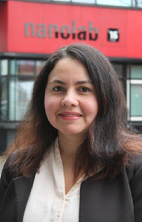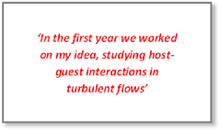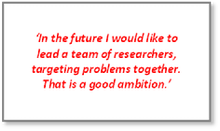 Multivalent non-covalent and porous nanomaterials, such as supramolecular nanoparticles (SNPs) and metal-organic frameworks (MOFs), are important for future applications, such as drug delivery systems and contrast agents. In this thesis, these otherwise very different materials are investigated, whether they can be controlled in size and outer functionalization. ‘This is done according to the same concept: ratiometic variation top, in order to provide a unified strategy for the formation of porous and self-assembled nanomaterials,’ Raquel Mejia-Ariza says. ‘I was very happy being able to fabricate and characterize SNPs and MOFs for future biomedical applications.’
Multivalent non-covalent and porous nanomaterials, such as supramolecular nanoparticles (SNPs) and metal-organic frameworks (MOFs), are important for future applications, such as drug delivery systems and contrast agents. In this thesis, these otherwise very different materials are investigated, whether they can be controlled in size and outer functionalization. ‘This is done according to the same concept: ratiometic variation top, in order to provide a unified strategy for the formation of porous and self-assembled nanomaterials,’ Raquel Mejia-Ariza says. ‘I was very happy being able to fabricate and characterize SNPs and MOFs for future biomedical applications.’
Designing nanoparticles for biomedical applications was a topic Raquel Mejia-Ariza already worked on in her master project at the Virgina Polytechnic Institute and State University. ‘It was a great opportunity for me to work on this VICI project as achieved by Professor Jurriaan Huskens from the Molecular Nanofabrication Group,’ Raquel says.
‘I came up with an idea in the first year of my PhD project. We worked on it, studying host-guest interactions in turbulent flows. Jurriaan Huskens gave me the opportunity to follow this specific line of research, which led to a good publication in the Journal of Materials Chemistry B. This gave me motivation and self-confidence to continue.’
Collaboration within MIRA

Other results followed. In the projects Raquel collaborated with a variety of experts. In order to characterize the functional surfaces to sense DNA using a non-covalent approach on MOF surfaces, the expertise of the Medical Cell BioPhysics Group, led by Professor Leon Terstappen, proved to be decisive.
‘With the flow cytometry equipment - making use of special dye markers – high-troughput screening of hundreds of thousands of particles is possible. Together with Christian Breukers we performed these experiments in the lab, always collaborating. This was of prime importance for achieving the proof of concept.’
University of Parma

To selectively sense DNA, synthesized biotin-PNA served as a ‘building block’. Here collaboration with the University of Parma was started, with Professor Roberto Corradini. Raquel: ‘Erasmus student Jessica Rosselli worked here at the Mesa+ institution for four months, finding the right conditions to produce the MOF fabrication needed for this project.’
Good ambition
The year after her PhD defense, Raquel will be working as a post-doc at Mesa+, finishing some extra lines of research. ‘After that I’m planning to go and work in industry, for example at a National Lab for cancer research. I would like to lead a team of researchers, targeting problems together. That is a good ambition.
‘During the PhD project I loved working with PhD students, leading them in the projects we started. Also I learned to work on multiple projects simultaneously. After two years here, I already worked on four projects in which more than five students and several other colleagues were involved. From these experiences I developed myself toward an independent researcher, used to work in multidisciplinary environments.’
